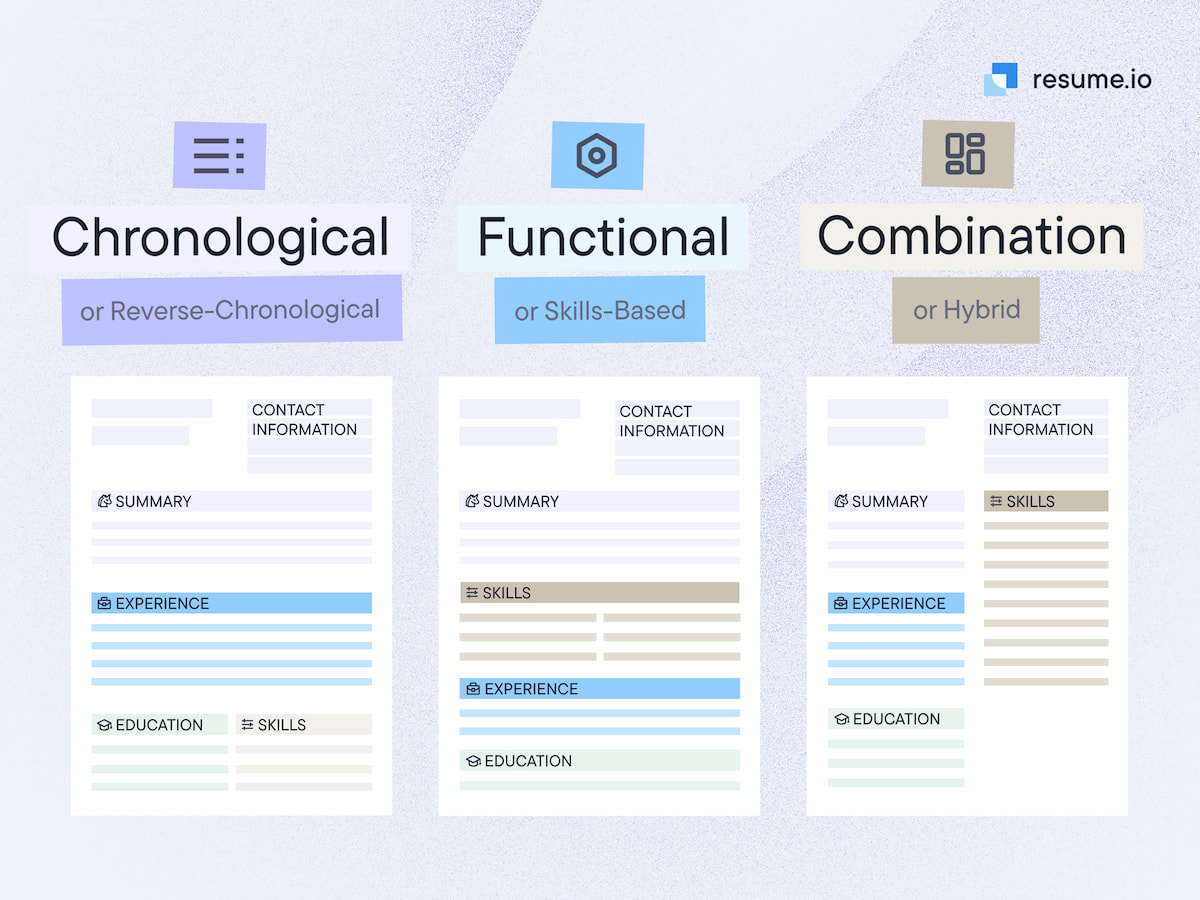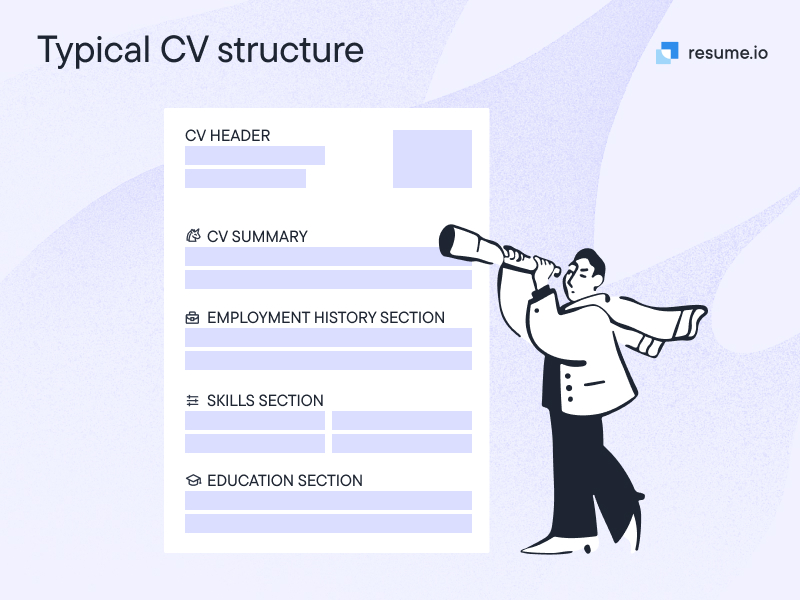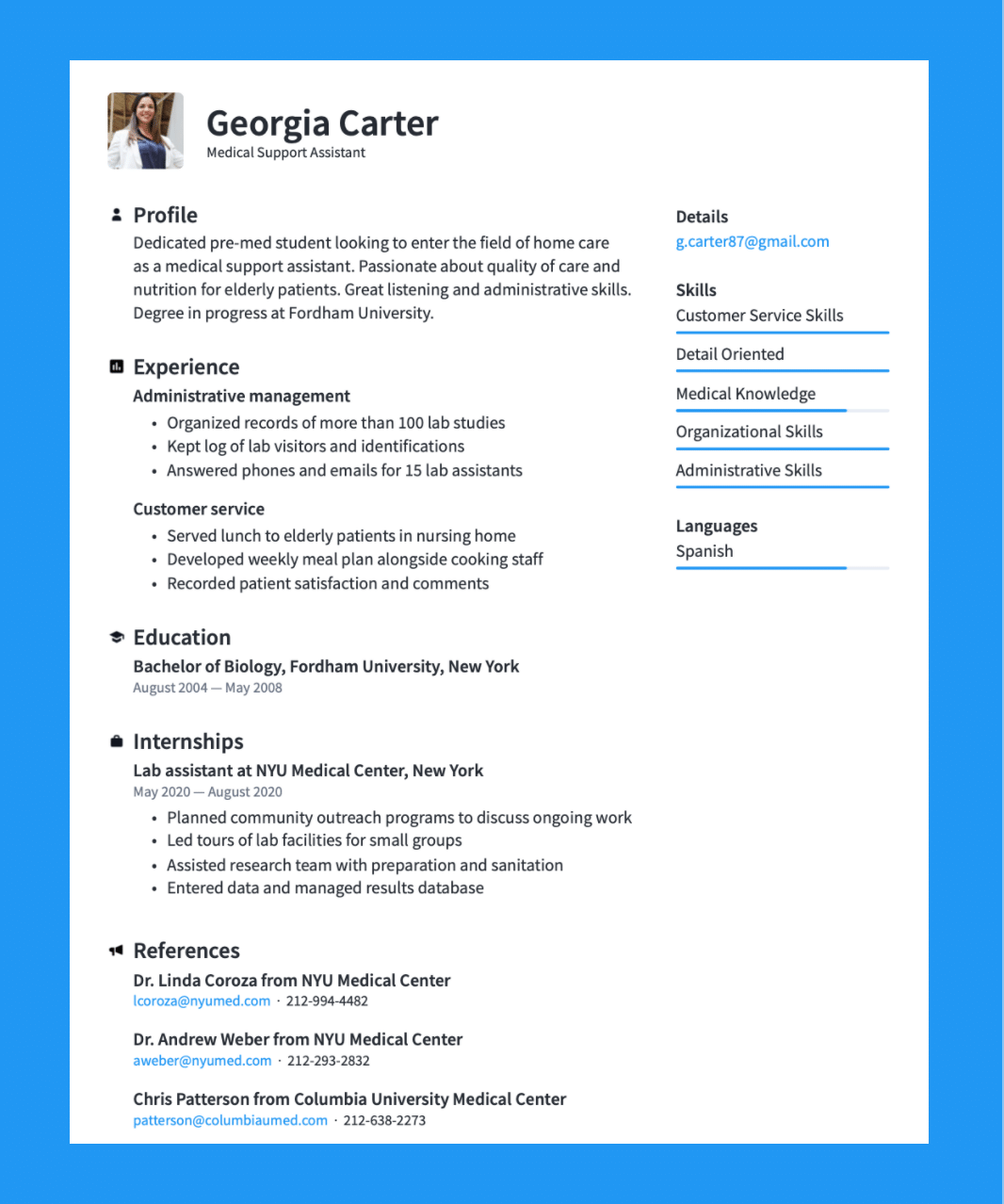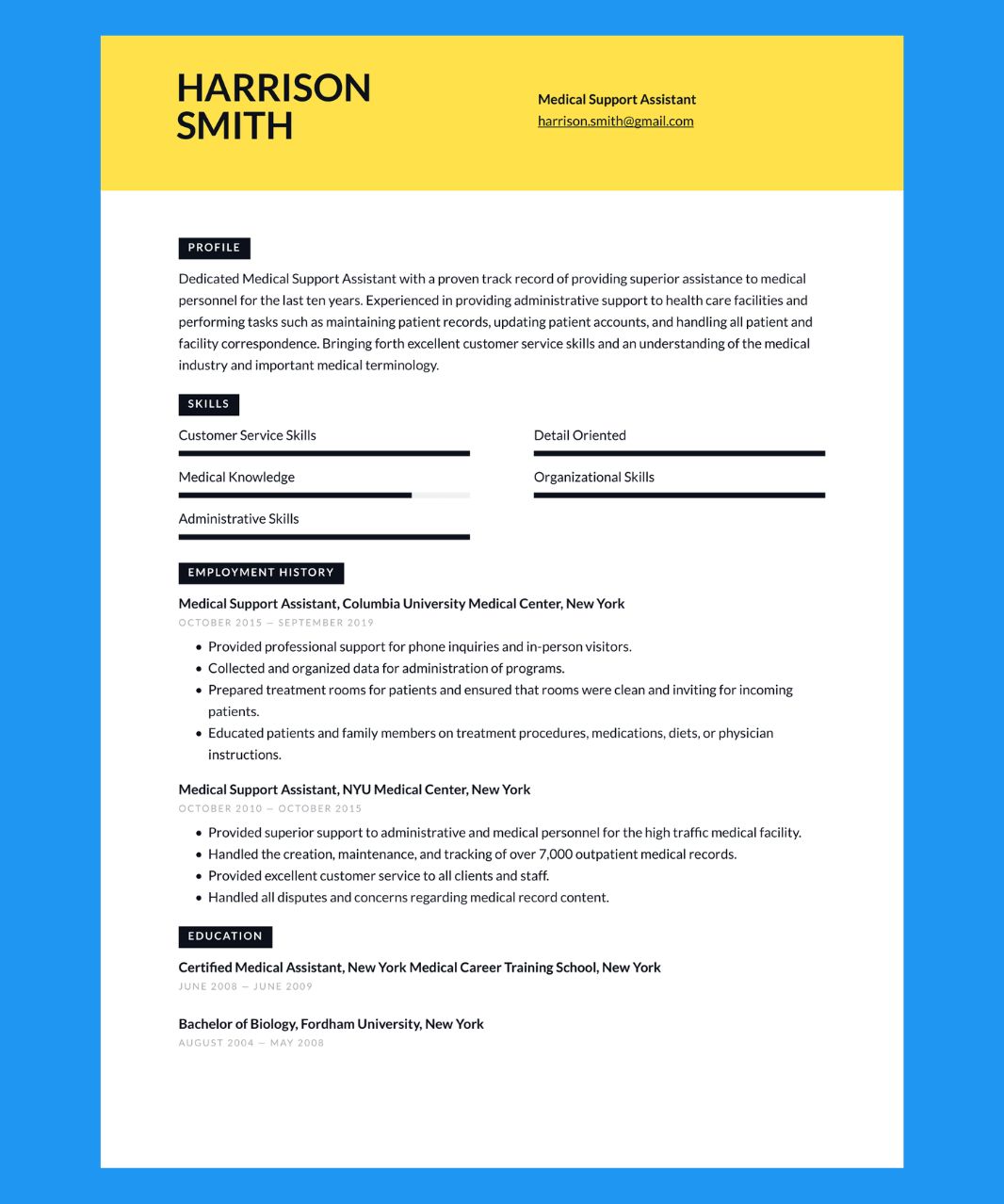Recruiters are often time-pressed, so their ability to quickly scan a CV and find the key information they need can increase your chances of success in a job search. For this reason, the CV format you choose is just as important as the information you include.
So, what exactly is the best CV format? The phrase “CV format” can actually be a little confusing, since different sources can refer to this as multiple things. CV format is the structure of your CV. It’s the overall look of your document and the CV layout used to present your skills, experience, and achievements. Presenting this information in a clear, attractive, and professional format will get it noticed by recruiters.
In this article, we’ll explore the different types of UK CV formats, including how to structure each format and their pros and cons. We’ll also share some expert formatting tips and FAQs to ensure that you have all the information you need.
Best CV format for a job search
Generally speaking, the reverse chronological format is the best UK CV format for a job search. This structure tells a story of your career progression that recruiters can easily follow, by listing your most recent work history first, then going backwards in time from there. Plus, this format can easily be scanned and parsed by applicant tracking systems (ATS).
However, this format is not ideal for every situation. If you’re a recent graduate, career changer, job hopper, or have significant employment gaps, an alternative CV format—such as functional or combination—is probably a better option. We’ll explore these structures in more detail next.
3 Main CV formats explained
Choosing the right CV format will ensure that you frame your skills and experience like a true work of art. Luckily, this is an easy process as there are just three main types of CV format to consider:
- Reverse chronological (traditional)
- Functional (skills-based)
- Combination (hybrid)

Reverse chronological (traditional) CV format
While you may be tempted to equate traditional with boring, in the CV world, think of the reverse chronological CV format as a timeless classic. There’s a good reason why this format is so popular with recruiters and has stuck around for so long.
In the reverse chronological structure, work experience is listed with the most recent role first and then moves backwards in time to each previous job. If you have a solid work history and relevant career accomplishments to showcase, then this structure is the perfect choice.
Here are the key elements of the reverse chronological CV format:
- CV summary. This personal statement sits at the top of your document and is the most freeform part of your application. Use this two to four sentence paragraph to grab the reader’s attention and illustrate why they should hire you.
- Employment history section. Outline your work experience so far, starting with the most recent and then going back around 10–15 years maximum. List your dates of employment, job title, employer’s name and location, then add results-based bullet points that show the impact you had in each role.
- CV skills section. Include both hard (industry-specific) skills and soft skills (adaptability, communication, teamwork) specific to each job opening.
- Education section. Stay with the reverse chronological format by listing your most recent and then subsequent qualifications, including the subject matter, educational institution, and date (if recently completed).

- Recruiters love the easy-to read format and clear career timeline.
- Best CV format for showcasing workplace achievements and career progression.
- Applicant tracking systems (ATS) can easily scan and parse your information correctly in this ATS CV format.
- Calls attention to gaps in employment and job hopping due to a focus on dates.
- If your most recent role is not relevant to your target role, this can negatively impact your candidacy.
- Repetitiveness can be a problem if you have worked in similar roles with different companies.
If you need advice on how to structure, write, and design a job-winning CV, check out our top-rated article on how to write a CV.
Functional (skills-based) CV format
Rather than emphasising work history, functional (or skills-based) CVs shift the focus to the relevant skills and talents you have acquired in your career to date. This CV format places your skills and work history into categories at the start of your CV, replacing the traditional reverse chronological work history section.
If you have zero work experience or your work history doesn’t relate to your target role, this format offers the perfect solution by shifting the focus from specific roles to transferable strengths.

Here are the key elements of the functional CV format:
- CV summary. Hook the reader’s attention with a brief snapshot (two to three sentences) of your skills, experience, and ability to contribute to company objectives.
- Skills section. Expand this section with greater detail on your relevant hard skills and soft skills. A good approach is to categorise these skills, such as project management, then add bullet points under each category to share how you honed this talent and demonstrate this skill in action. In this example, a two column CV is being used.
- Education. Stick to reverse chronological order to list each qualification (subject and level), educational institute, and date (if recently completed). If you are currently completing a certification relevant to your target role, include this as “In progress.”
- Work history. Since a functional CV format is more focused on skills, your work history section can be brief. Simply list the job title, company name, and employment dates.
- Great option for recent graduates or individuals re-entering the workforce after a long break.
- Perfect for career changers. Transferable skills from the original career are highlighted to address suitability for a new direction.
- Best way to highlight education and abilities if you have zero work experience.
- Not a popular format with recruiters. Some may be suspicious as to why you are trying to de-emphasise your work history.
- Can make you look like an inexperienced candidate due to minimal information on specific work experience.
- ATS finds this format difficult to parse, due to the lack of a straightforward career timeline.
Combination (hybrid) CV format
Often considered the baby of the reverse chronological and functional CV formats, the combination or hybrid CV places equal weight on both skills and work experience. Typically, relevant skills and abilities are placed at the beginning of the resume, closely followed by work history.
This format is a great way to showcase your skills while also providing the hiring manager with a picture of your chronological work history, which is usually what they want to see.

Here are the key elements of the combination CV format:
- CV profile. Describe yourself as a professional in a short paragraph. Consider your unique selling points (USP) and what you bring to the table that no other candidates can. Make sure to relate this summary to the specific job opening to show how you’re the perfect fit.
- Skills section. Identify your most recent, relevant, and impressive skills areas, then make each one a heading and list examples of your strengths below. For example, if you’re a freelance tech professional, you could include a skill category of software development with specific expertise and a standout project listed below. Make sure to add soft skill categories too.
- Work experience. Your work history is of equal importance on a hybrid CV. This should follow the reverse chronological format with your most recent job first. Under each job heading, use bullet points to describe what you achieved in each role.
- Education. Likewise, list your education in reverse chronological order from highest to lowest level. If you have completed a degree and postgraduate qualifications, there is no need to include your secondary education.
- Emphasises your key strengths and work experience in equal measure.
- Perfect for freelancers or project-based workers. Highlights top skills followed by relevant projects in work history.
- Enhances your current CV if you have limited work experience or are shifting to a new field.
- Not as suitable for professionals with a traditional career trajectory.
- Might give the impression that you're early on in your career, even if you have plenty of experience.
- Can be challenging to strike the right balance between the sections as both require an equal footing.
How to format a CV for the UK
Now that we’ve pinned down the key elements for choosing a CV format, it’s important to remember that the layout of your CV will also have an effect on its success. A well-crafted and properly formatted CV can help you stand out from other candidates and allow hiring managers to quickly identify your qualifications.
Here are some tips to ensure that you have a well-laid out CV format for the UK:
- Style. Keep the design simple from start to finish. You don’t want to confuse the hiring manager by using a complicated look. Use one of our tried and tested CV templates.
- Section headers. Use section headers to divide up your CV, with a larger font size in bold, so that they stand out from the rest of the information.
- CV font. Select a simple and professional font for your cover letter, such as Arial, Calibri, or Verdana, and keep the font size between 11–12 pt. for readability.
- Bullet points. Use bullet points to create white space and break up information into succinct, easy-to-read points.
- Margins. Ensuring there is sufficient white space around your CV will make it more readable and less cluttered. Aim for 2.5 centimetre margins all around.
- Spacing. If everything is crammed together on your CV or there are uneven gaps, the overall look will be unprofessional. Keep the amount of spacing between each section heading and any subsections exactly the same, ideally between 8 pt. and 12 pt.
- Page length. Your CV format should be no longer than two pages. Employers prefer a concise document detailing the most recent and relevant experience and achievements.
- CV photo. In the UK, there is no need to provide a photo on your CV. This is not expected and can also help avoid any discrimination issues.
CV format examples by job types
Here are some different UK CV formats for job types and levels that you can use for inspiration or adapt to your requirements:
Entry level CV format
Launch your career with a compelling entry-level CV format that presents your top-level skills and qualifications in a clear, concise, and professional way.
Experienced CV format
Make the hiring manager’s job easy by opting for the experienced CV format that tracks a clear timeline of your career progression. This format is perfect for job seekers and natural leaders with a solid work history and standout achievements.
Modern CV format
Modern CV templates are a great choice for candidates with careers in fields such as design, architecture, marketing, IT, media, and more. These CV formats can help speak to your originality without coming across as eccentric or out of touch.
Simple CV format
Simple CV templates are clean and organised so that the focus never strays from your skills and experience. This is perfect for a variety of positions and fields, from students and career starters to more experienced candidates in technology, construction, or logistics.
Professional CV format
Professional templates offer the perfect combination of eye-catching elegance and timeless style for a CV that speaks to your talent and expertise. This type of job CV format is ideal for candidates in fields like business and management, accounting and finance, medicine, education, and law.
CV format FAQs
Does the CV format matter?
Yes! Prospective employers will notice the layout of your CV before they even read it. The right CV format projects your professionalism and highlights your top-level skills, experience, and achievements. This will entice the hiring manager to read on and learn more about you.
Which CV format do most employers prefer?
The majority of employers prefer reverse chronological, due to this format offering a straightforward overview of your entire career path. When used effectively, the work experience section will emphasise key skills that the employer is looking for.
What is the most readable CV format?
Reverse chronological format would probably win this again, purely for the fact that the structure is easy to read by both humans and applicant tracking systems (ATS). If your CV is scanned incorrectly by an ATS, then you might not even make it to the human review, so this matters.




